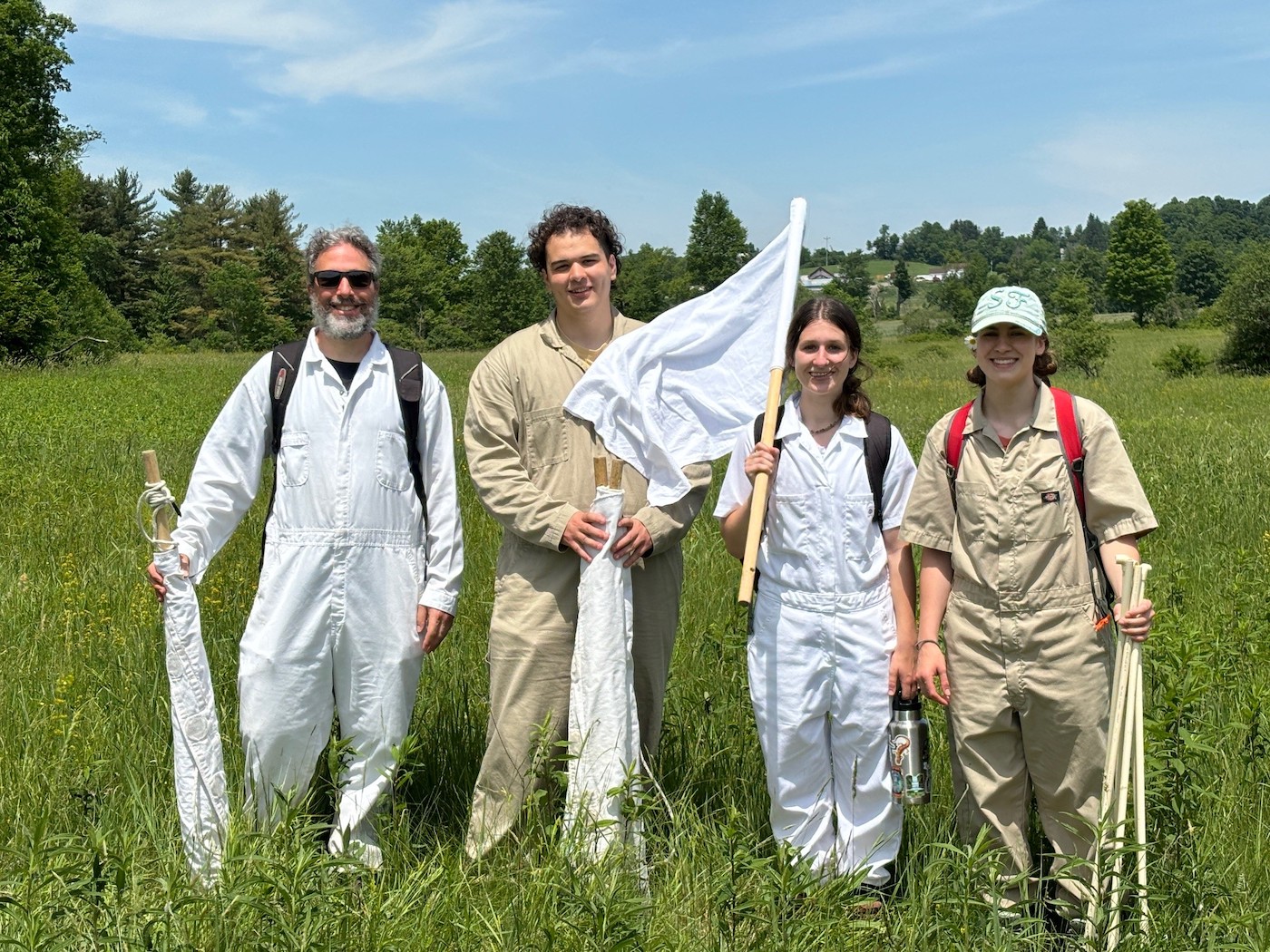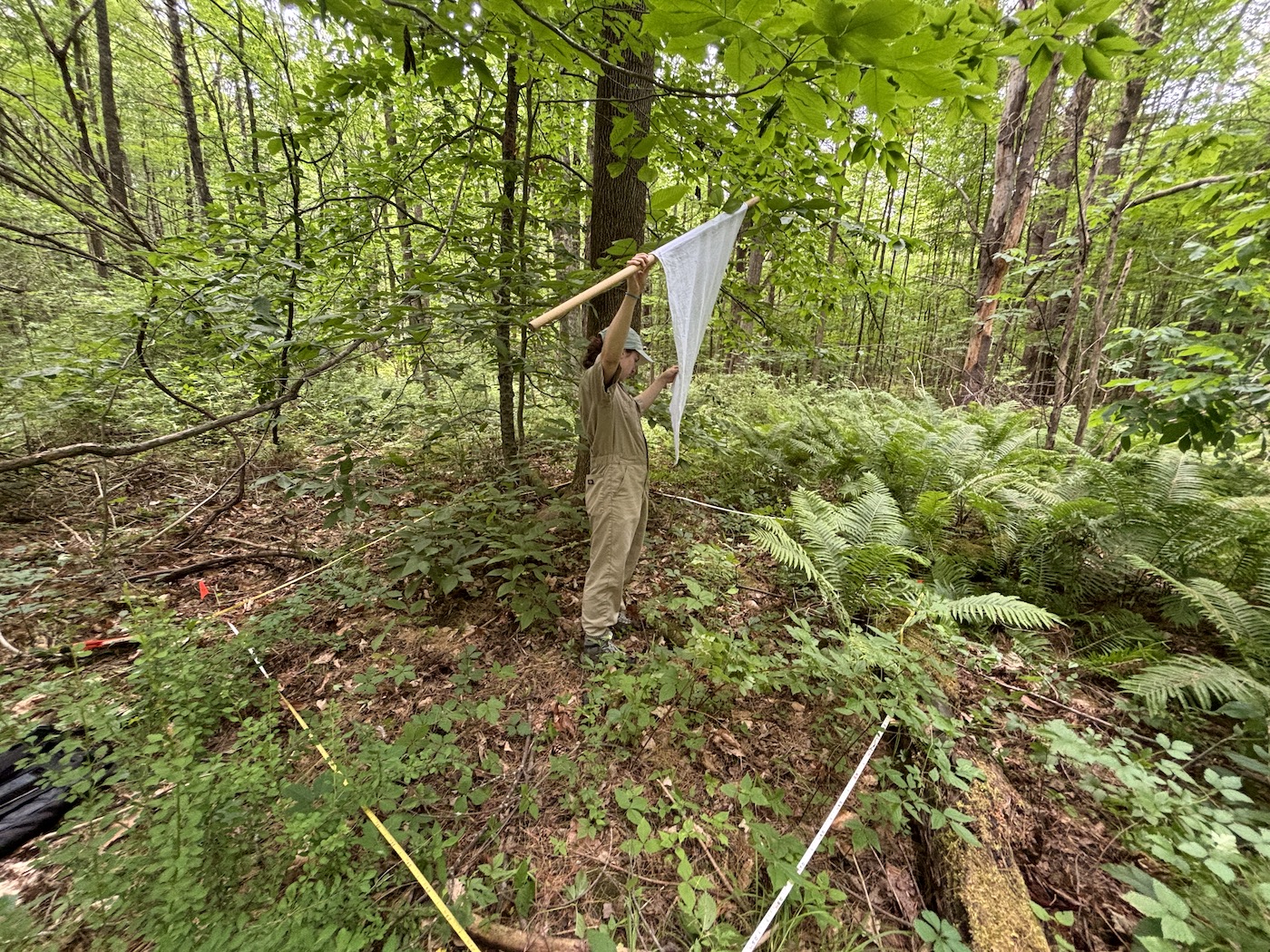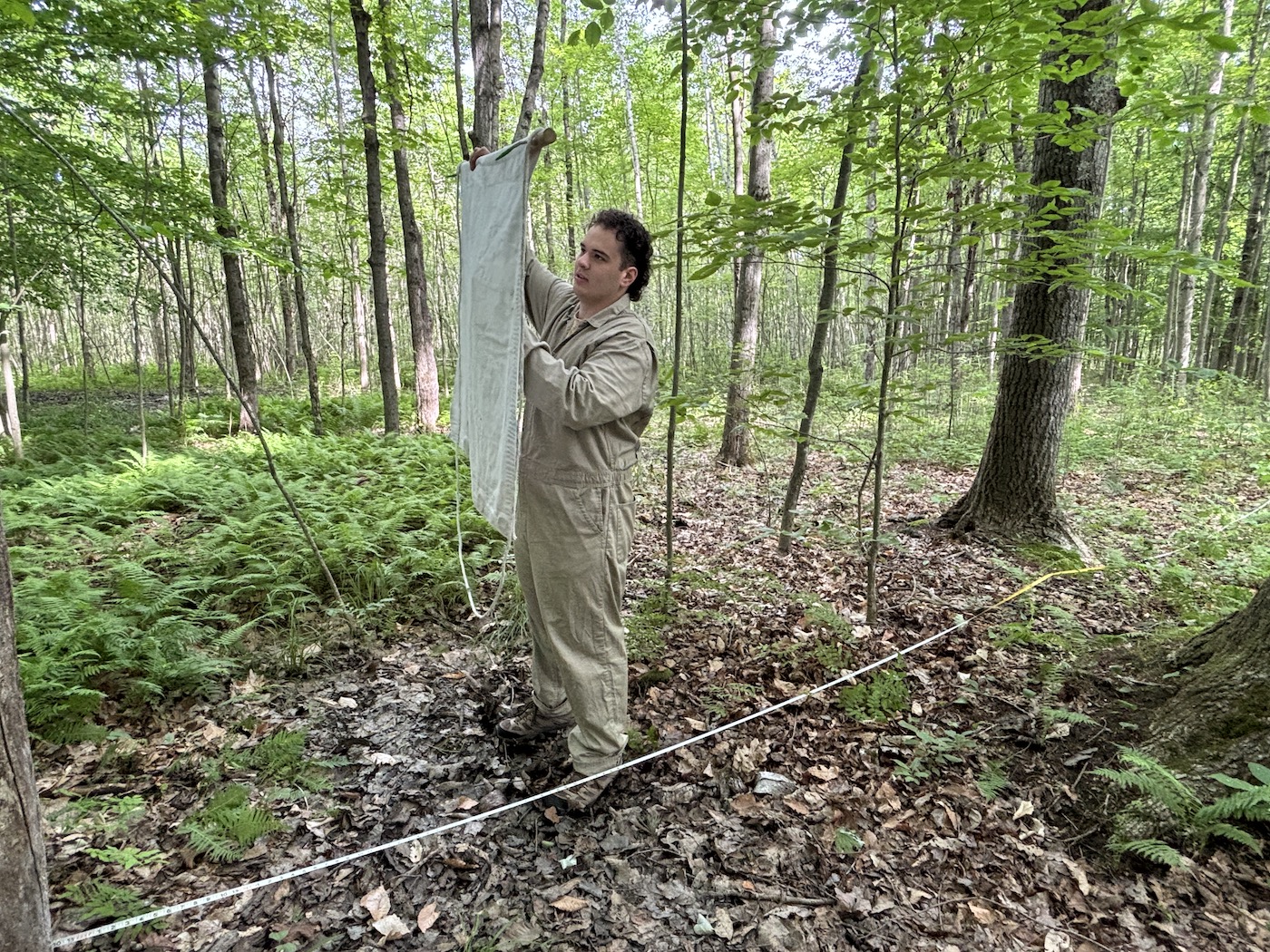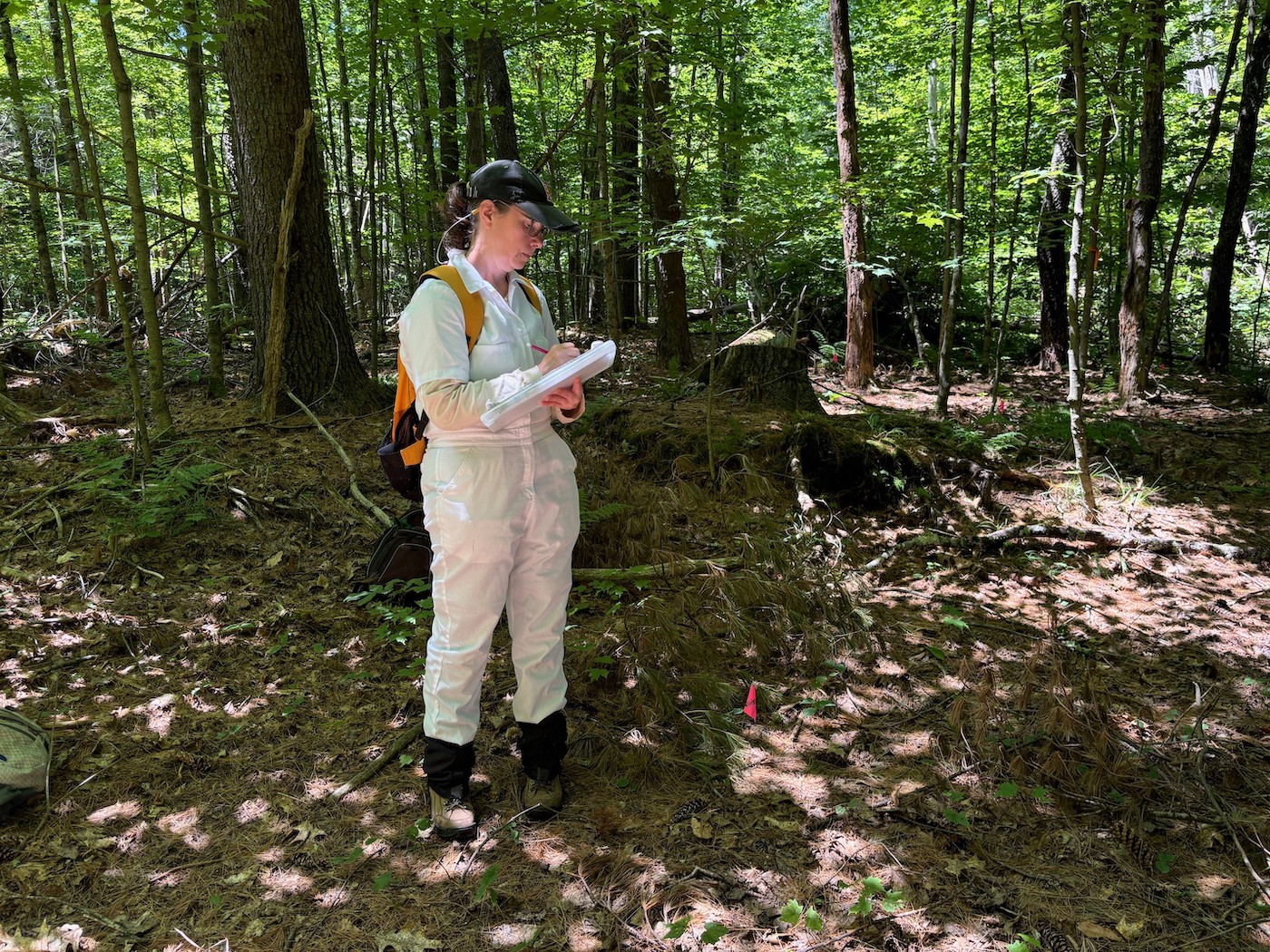Managing Some Invasive Plants Might Reduce Blacklegged Ticks
6:59 minutes


This article is part of The State of Science, a series featuring science stories from public radio stations across the United States. This story, by Lexi Krupp, was originally published by Vermont Public.
In much of the eastern US, October and November usher in an autumn peak of the blacklegged tick season.
For years, researchers have noticed that these ticks, also called deer ticks, are more abundant on certain invasive plant species, like Japanese barberry, that create dense thickets in the forest understory.
Now, a group of scientists in Vermont and Maine is investigating how managing these plants might decrease the number of blacklegged ticks—and the risk of people developing tick-borne illnesses, like Lyme disease and Babesiosis. After getting a $1.8 million grant from the National Science Foundation, they’re hoping to come up with guidance for landowners.

Over the next five years, Dr. Allie Gardner, a medical entomologist at the University of Maine, and other researchers will survey tick numbers and test out different management techniques at around 30 locations on private and public land in northern New England. Then, they’ll train landowners on best practices for managing ticks and invasive species.
“We can do all the ecological research we want on the problem, but if we are not able to translate our findings into recommendations, ultimately we are not going to make any headway,” says Gardner, the lead researcher on the project.
It’s not entirely clear why ticks are more likely to be found on some invasive species compared to native plants, but there are several theories.
“The humidity levels around Japanese barberry seems kind of ideal for ticks,” says Dr. Kristen Ross, a restoration ecologist at Vermont State University and a collaborator on the project. “They like it not too rainy and not too dry.”
Keep up with the week’s essential science news headlines, plus stories that offer extra joy and awe.
Tangled thickets of barberry in a forest’s understory also provide cover for white-footed mice, a main host of blacklegged ticks.
“They can hide in these really dense infestations and it’s very hard for natural predators of mice to get in because the invasive plant infestations are so thick,” Gardner adds.
She thinks there might be more blacklegged ticks on other common invasives that can become a monoculture in the forest understory, like honeysuckle and buckthorn.
“We really haven’t actively looked for it before,” she says.

Other researchers, like Dr. Thomas Mather, a tick ecologist at the University of Rhode Island, point out there are many variables that determine where blacklegged ticks show up on the landscape, and invasive plants are just one of them.
“I would argue I could find lots of places now with non-invasive plants that have lots and lots of ticks as well. So I’m slightly a skeptic,” says Mather, who is not involved in the project.
He thinks the link that’s been documented between species like barberry and blacklegged ticks might be overblown. “If you were to look at people’s interpretation of those studies, you would think, ‘Oh, as soon as you go over to a barberry, instead of those little red berries, they’re going to be raining ticks on you.’ It’s not that way.”
And removing invasive species is not going to eliminate ticks entirely.
“There is this question of, how much of a reduction does there need to be before you see a reduced risk [of disease],” says Dr. Bill Landesman, a tick ecologist and collaborator on the project, also at Vermont State University.
Other strategies, like doing tick checks or using chemical controls might ultimately be a more efficient way to manage the risk of disease than invasive species removal, according to Mather.
“The effort to manage that is huge compared to simpler things that also work, like spraying insecticides,” he says.

For her part, Gardner hopes the research will spread awareness of the possible link between invasives and blacklegged ticks, and perhaps give people another reason to manage some of the invasive species on their property.
“We know that there’s an intense dislike of invasive plants, and, similarly, of ticks,” she says.
“We’re looking for win-wins.”
Invest in quality science journalism by making a donation to Science Friday.
Lexi Krupp is a science and health reporter at Vermont Public in Burlington, Vermont.
IRA FLATOW: This is Science Friday. I’m Ira Flatow. And now it’s time to check in on the state of science.
SPEAKER 1: This is KER–
SPEAKER 2: For WWNO–
SPEAKER 3: Saint Louis Public Radio.
SPEAKER 4: Iowa Public Radio News.
IRA FLATOW: Local science stories of National significance. Blacklegged ticks, or deer ticks, are a big problem for both people and Wildlife in the Eastern US. Their bites can spread debilitating bacterial infections like Lyme disease, and their populations have spread over the past few decades. Researchers in Vermont and Maine have noticed an interesting correlation between ticks and invasive plant species.
A better understanding of this could have an impact on how we manage both. Here’s sci-fi producer Kathleen Davis with more.
KATHLEEN DAVIS: Thanks, Ira. Joining me now to talk about this project is my guest, Lexi Krupp, Science and Health reporter for Vermont Public, based in Burlington, Vermont. Lexi, welcome to Science Friday.
LEXI KRUPP: Thanks for having me.
KATHLEEN DAVIS: So tell us about this project that you reported on. What exactly are these researchers in Vermont and Maine trying to figure out?
LEXI KRUPP: Just backing up for a minute, there have been a couple studies showing this link between an invasive shrub, Japanese Barberry, and black legged ticks. And if you haven’t seen barberry, it’s this bush that can grow over your head. It has small leaves that turn red in the fall and bright red berries. It’s pretty. A lot of people will plant it in their yards.
But in the forest, it can really take over the understory. A while back, researchers in Maine noticed that there were way more black legged ticks on these plants, twice as many ticks in forests with Japanese Barberry compared to nearby forests with native shrubs. Then a few years ago in Connecticut, other researchers found if you cut down barberry, there’s fewer ticks. So this new project that I covered is funded by the National Science Foundation.
They have almost $2 million to test this idea out over a longer time period, five years. So these researchers are going to experiment with different methods of removing these plants. They’re looking at whether you see a reduction in tick numbers nearby in surrounding areas.
And they’re looking at other invasive species, too, plants like honeysuckle and common buckthorn that also take over the understory of forests to see, can we find this connection between ticks and invasive plants as well? Associate Professor Ali Gardner is the project lead. She’s a medical entomologist at the University of Maine. And she said at the end of this study, she really wants to be able to give landowners practical advice.
KATHLEEN DAVIS: The bottom line is that we can do all the ecological research we want on the problem, but if we’re not actually able to translate our findings into recommendations, ultimately, we’re not going to make any headway on the problem. So what’s the science behind what these researchers are saying? I mean, why do ticks seem to these invasive plants?
LEXI KRUPP: One thing that might be going on is black legged ticks, like sort of damp environments. They’ll actually dry out if they get too much sun. And barberry and maybe some of these other invasives, too, offers this dense, shady habitat where ticks can hang out. Another piece of the story here is the other animals that are part of a ticks life cycle, which is mainly white footed mice and white tailed deer.
Mice and deer also like to hang out in these areas with plants like barberry and honeysuckle. They offer some protection from predators. And while mice and deer are seeking shelter in these areas, they’re also carrying a bunch of ticks.
KATHLEEN DAVIS: Hold on. Just let me get some clarity on something. Is it still tick season right now? I was always under the impression that tick season was in spring and summer.
LEXI KRUPP: It is still tick season. And this is really confusing because the mosquitoes are gone. It feels like ticks should be gone, too. But that’s just not how their biology works. October and November is actually the peak of black legged tick season in most of the Eastern US. Where I live in Vermont, this is when there are the most emergency room visits because of tick bites outside of the spring.
And I think this is surprising every year because you find very few ticks in August and September, and that’s because ticks are around, but they’re teeny tiny, basically, baby ticks. And they don’t bite people and dogs. So it’s not until they get to this adult phase later in the fall that they start looking for what’s called a blood meal.
KATHLEEN DAVIS: So this project that we’re talking about, it seems like it could be the perfect solution for two problems. You’re getting rid of invasive plants to get rid of ticks. But is this too good to be true? I mean, are there skeptics to this idea?
LEXI KRUPP: Yeah. I think one issue here is that there are just so many variables when it comes to habitats that ticks like. I spoke to Professor Thomas Mather about this. He’s a tick ecologist at the University of Rhode Island and runs this program called Tick Encounter. And he said you can certainly find ticks in places with invasive species, but there’s also lots of ticks in areas without any invasive plants. And he’s cautious about this connection between black legged ticks and an invasive species like barberry.
THOMAS MATHER: If you were to look at people’s interpretation of those studies would think, oh, as soon as you go over to a barberry instead of those little red berries, they’re going to be raining ticks on you. It’s not that way.
LEXI KRUPP: And he made this point that if you really want to reduce your risk of tick borne illnesses, there’s probably easier ways to do it than removing a bunch of invasive plants. Tick checks are really effective, and so is spraying insecticides that are targeted at ticks.
KATHLEEN DAVIS: So what’s next for this project?
LEXI KRUPP: The research I talked about is starting next year and they’re still figuring out all the details. But the goal is to come out of this with best practices for how to manage invasive plants with the best shot at reducing tick numbers. And I think another goal is to spread awareness of this connection between invasive plants and black legged ticks. That might give people another reason to manage some of these invasive species on their properties.
KATHLEEN DAVIS: Well, that’s all the time that we have for now. I’d like to thank my guest, Lexi Krupp, Science and Health reporter for Vermont Public, based in Burlington, Vermont. Thanks so much for being here.
LEXI KRUPP: It was a pleasure.
Copyright © 2024 Science Friday Initiative. All rights reserved. Science Friday transcripts are produced on a tight deadline by 3Play Media. Fidelity to the original aired/published audio or video file might vary, and text might be updated or amended in the future. For the authoritative record of Science Friday’s programming, please visit the original aired/published recording. For terms of use and more information, visit our policies pages at http://www.sciencefriday.com/about/policies/
Kathleen Davis is a producer and fill-in host at Science Friday, which means she spends her weeks researching, writing, editing, and sometimes talking into a microphone. She’s always eager to talk about freshwater lakes and Coney Island diners.
Ira Flatow is the founder and host of Science Friday. His green thumb has revived many an office plant at death’s door.